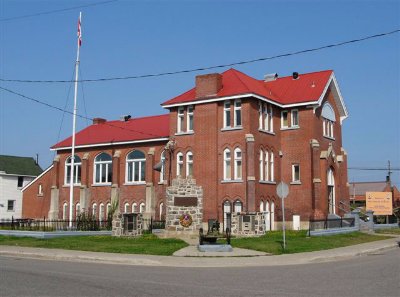
|
No.11 |
The Legion By George Evans |
Index |

|
|
This is about the building, not the veterans� organization. The inscription on the front, outside wall, just above the 2nd floor windows, is not always easy to read. St. John�s Parish House Lorne W. Nicholson had signed up in the recruitment drive of 1916 ( See No. 3 in this series ). He went overseas with the First Chapleau Platoon of the 227th Battalion of the Sudbury, Manitoulin, and Algoma Overseas Battalion and he was killed on the Western Front on November 4, 1918, one week before the war ended. His father was George B. Nicholson, a former railroader turned lumber baron. His mother was the former Miss Weller, one of Chapleau�s earliest school-teachers. They had been married in 1894. Read more about George B. Nicholson here. 
Lorne�s parents included in their grief all those young men who had shared Lorne�s fate in the Great War. Out of their pain they decided to endow the community with a lasting and useful memorial. In a town of small buildings made of wood, they caused to be built an impressive building of fired brick, matching St. John�s church (1908) and the new town hall (1915). It is significant that the donors of the building did not put their names on the monumental inscription: they were content that the world remember them simply as the father and mother of Lt. Lorne W. Nicholson. The scripture cited in that same inscription reads
|
Things did not work out exactly as the Nicholsons had intended. Maintaining their gift to St. John�s Anglican Church proved to be too costly for the small congregation and, according to Vincent Crichton�s Pioneering in Northern Ontario, the building was closed in the early 1940s. Eventually, the building was acquired by the Royal Canadian Legion, Branch No. 5, which has maintained and improved it, thanks largely to the fund-raising talents of the Ladies� Auxiliary. As a result, the Nicholsons� gift, now known simply as �the Legion� fell into responsible hands and has continued to be a great asset to the life of Chapleau. The upper hall, known as Cranston Hall after the last survivor of the Great War, has been home to a wide variety of functions ranging from wedding banquets and Rotary meetings to graduation dances and political rallies. For many years �until wheel-chair accessibility became an issue�provincial court was held here and ballots were cast in municipal, provincial, and federal elections. Downstairs, the Bisco Room has become a legendary place where members of the Legion and their guests can socialize and mark special occasions. The Nicholsons, wherever they may be, must be very pleased to see how the veterans� organization that sprang up after the Great War has made their memorial to Lorne and his comrades a lasting landmark in the social history of Chapleau. 
The bronze plaque on the 1914-18 wing of the cenotaph quotes the Scriptural citation on the inscription over the door, John 15:13. In 2019, just thirteen years from now, the Legion building will celebrate its 100th birthday. It is a handsome and historic structure. Who in Chapleau cannot recall a significant event in his or her life that occurred in the Legion? Unlike other public buildings such as the old Sacred Heart School, the old High School, the old Town Hall, the old Fire Hall, the old Curling Club, and the old Arena �all of which have disappeared�the Legion remains robust and alive. May it still be going strong in 2019, serving the town and always reminding those who take the time to lean back and read the inscription high above the door of the sacrifice and pain of our forebears who lived in the barbarous 20th century. Written by George Evans, based on material found in the book, Pioneering in Northern Ontario, by Vincent Crichton. Photos © by George Evans |
| To the Top |